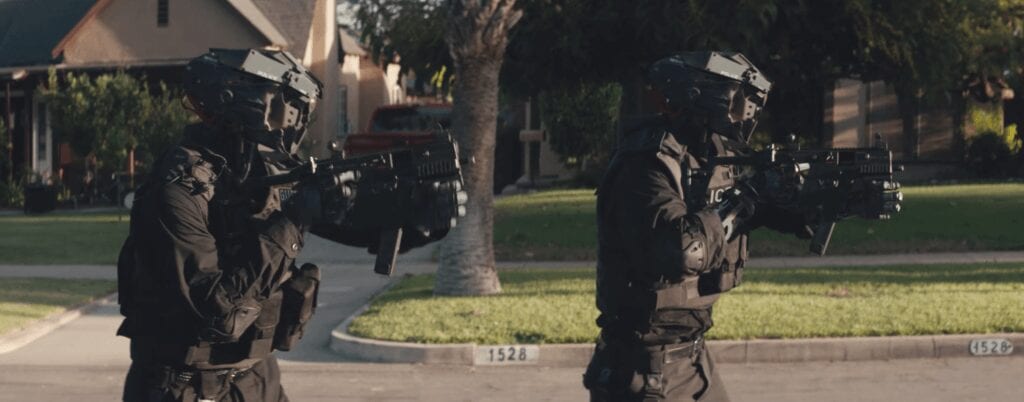Why I’m Excited: Code 8
The superhero genre has grown in a myriad of ways throughout the last decade. While you could certainly argue the MCU was a factor in this evolution, the Arrowverse has also contributed in major ways, and that is due to Stephen Amell’s work on the first two seasons of Arrow. I remember when Amell was first cast in the role. I was initially upset, as I had been hoping for Justin Hartley to reprise the role in a Smallville spinoff. But from his first Facebook video, where he spoke about how he felt people would be surprised by the Arrow pilot, I was intrigued. He seemed to be really into playing a superhero, and over the years he has always acted as a great ambassador for the Arrowverse brand, even joking how the guest stars often see him as management. Despite this, Amell is always looking to the future, whether it’s Nocking Point wines, co-founding Heroes and Villains Fan Fest, or even developing a travel show. Then, of course, there are his ventures into film, particularly playing Casey Jones in Teenage Mutant Ninja Turtles: Out of the Shadows, a role he said he took with his Arrow fan base in mind. This fact is what makes the subject of this week’s Why I’m Excited, Code 8, so intriguing.
When Code 8 (which was first bought together by his cousin and The Tomorrow People star Robbie Amell) was first being discussed, Amell mentioned how his goal going forward was to own a piece of anything of which he was a part. To lend his talent to another superhero project at a time when the comic book genre is at its zenith is incredibly exciting. When I first saw the “Code 8” short film that was used to promote the Indiegogo, I was instantly reminded of another short, “The Raven,” which was in development as a starring vehicle for Mark Wahlberg. There were a lot of similarities between the two, where you had a superpowered individual being hunted by futuristic law enforcement. Where I would argue these two differ is that “Code 8” actually took the time to develop Robbie Amell’s character and get us emotionally invested in the narrative, whereas “The Raven” was more or less a really cool extended chase sequence, a proof of concept. While I’m sure the latter would have been built out in a feature-length film, the fact that the Amells already had a team in place ready to go, along with their Arrowverse fan base, really helped the project get to the point where they could film the movie.
Code 8 serves as a next step for both actors’ careers, particularly for Robbie Amell. When he was cast as one half of Firestorm on The Flash, I was very excited, as I had been following him since his time playing Fred in two of the Scooby-Doo live-action films. When he first got the lead in The Tomorrow People, I was happy his career was progressing, and that he was joining his cousin for “Amellsday.” Although they announced Legends of Tomorrow long after his character was killed off, I couldn’t help but wonder if he would be coming back to the Arrowverse in typical comic book fashion. When that turned out not to be the case, I was curious about what his next move would be, but I had no idea it would be another superhero property, and one of his own making no less.
In an age of crowdfunding, filmmakers can get their work out there and let the audience decide whether it has merit. This concept has been a boon to not only the independent crowd but also to high-profile actors like the Amells, particularly in a time where it becomes harder to get things through the development stage and onto the screen, nevermind reaching a wide audience. Yet because these actors are so focused on making something for the fans, they chose to bypass the studio system – a studio system that is arguably going through another transition, as it did several decades ago, just before the arrival of Star Wars. During the documentary Empire of Dreams, George Lucas explained what happened in the late sixties, with the demise of the studio system and how the executives sold off the studios to people who knew more about marketing than they did about the creative side of things. As a result of this, new criteria was born for the development and production of movies. Thanks to projects like Code 8, this criteria has been expanded to allow more audience participation.
Situations like this make me glad we live in the time that we do. In the seventies, Code 8 would arguably slip between the cracks and no one would get to see it, and that’s if the film was even made in the first place. Yet with crowdfunding and all the other avenues available to creators, the audience can decide what they want to see instead of a marketing team trying to figure out for whom this movie was made. This, in turn, gave way to the term “four-quadrant movie,” or, in other words, a movie that is designed for the widest audience possible. As a result of this, much of the genre fare released today is homogenized and, in many ways, is like trying to fit a square peg into a round hole. The only way for the industry to grow now is to expand the hole, and with the help of a few industrious artists, there is so much potential for great storytelling.
Code 8 is the culmination of a historic evolution. With an existing fan base, a high concept, and an industrious attitude, this superhero film has the chance to be the launching pad for a new storytelling universe. Although Code 8 took a little longer to get here than most fans would like, I have no doubt the Amells have made it worth our while. I can’t wait to see the results of the crowdfunding campaign when the movie premieres this April.








